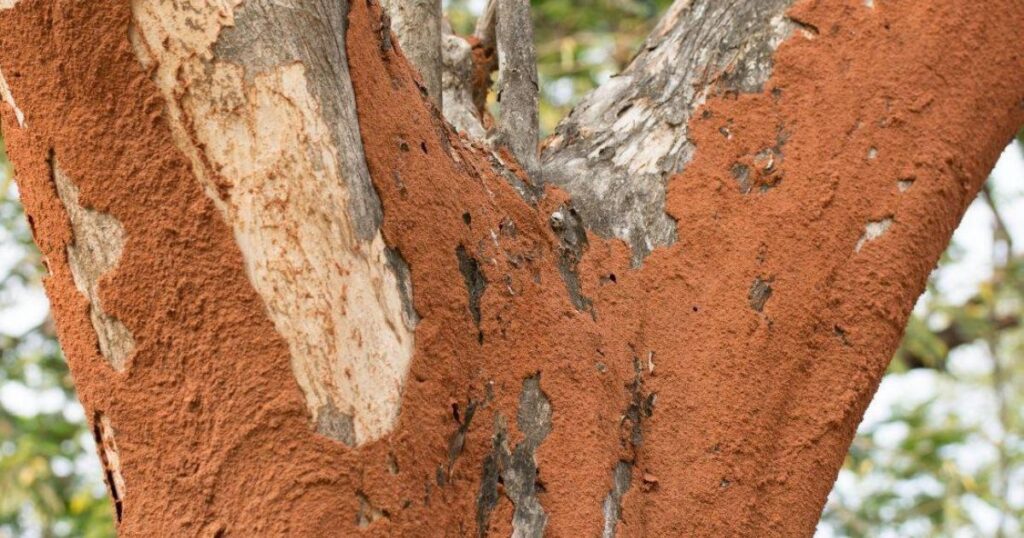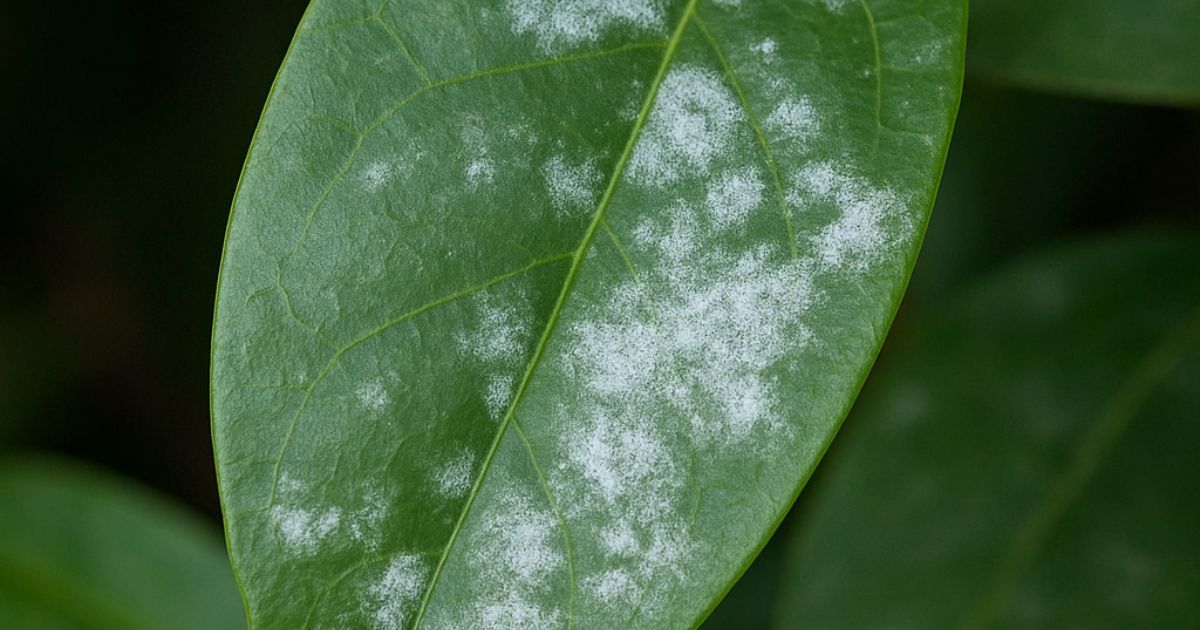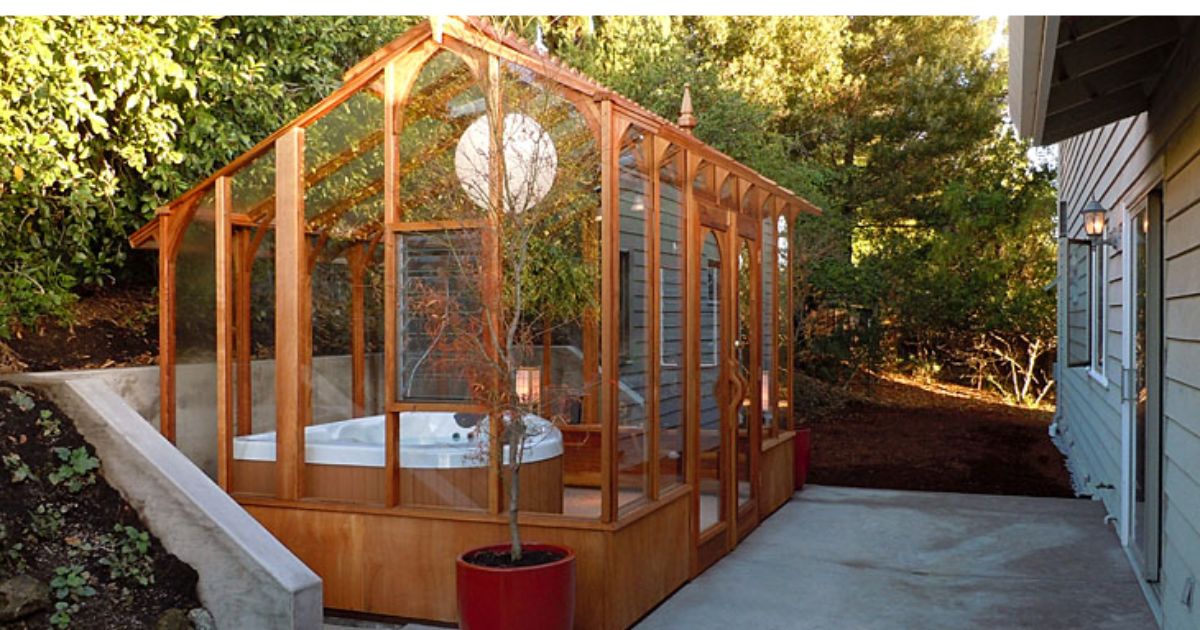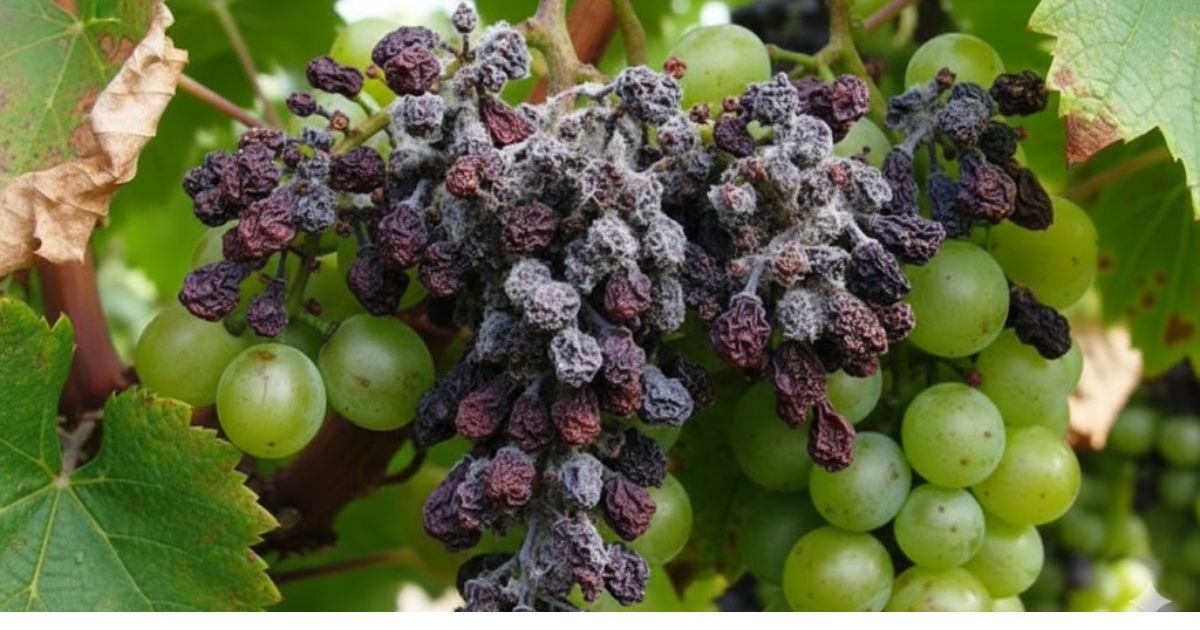Cutting down a tree might seem like the end of your termite worries, but in reality, it can be just the beginning. Even after a tree is removed, its remaining roots, stump, and decaying wood beneath the soil can still attract termites. These hidden pests feed on leftover cellulose and may eventually spread to nearby plants, fences, or even your home’s foundation.
Preventing termites after cutting down a tree is necessary to avoid long-term harm to your property. By understanding how termites behave and taking preventive steps such as proper stump removal, soil treatment, and regular inspection, you can stop these wood-destroying insects before they become a costly problem.In this guide, we’ll explore the best ways to keep termites away after tree removal, ensuring your garden and home remain safe, clean, and pest-free.
Understanding Why Termites Remain After Tree Removal
Many homeowners assume that cutting down a tree will automatically eliminate any termite threat, but that’s rarely the case. Termites are persistent pests that can survive long after a tree has been removed because the underground environment remains ideal for them.When a tree is cut down, the visible trunk and branches are gone, but the roots and stump beneath the soil still contain cellulose, the primary food source for termites. These insects continue to feed on the decaying wood, thriving in the moist, dark soil conditions where the stump once stood. Over time, the colony can grow and even spread to nearby structures, fences, or healthy trees.
In some cases, the termite colony might not even have been centred in the tree itself; How to Fix Cherry Tree Leaves Turning Brown it could have been living in the surrounding soil. This means that even after the tree is gone, the colony remains active underground, searching for new food sources.Understanding this behaviour is the first step in preventing reinfestation. Simply removing the tree isn’t enough; you must also deal with the leftover wood, roots, and soil conditions that continue to attract termites.
Signs of Termite Activity Around the Removed Tree Area
After removing a tree, it’s essential to keep an eye on the area for any lingering signs of termites. These pests are often silent invaders, working below the surface and inside decaying termites on trees, making early detection crucial. Here are the key indicators to watch for:
Mud Tubes or Tunnels
Termites build narrow mud tubes along the ground or tree stumps to protect themselves from sunlight and dryness. These pencil-sized tubes often connect the soil to a food source, like old roots or wood debris. If you notice these tunnels, it’s a strong sign of ongoing termite activity.
Hollow or Soft Wood
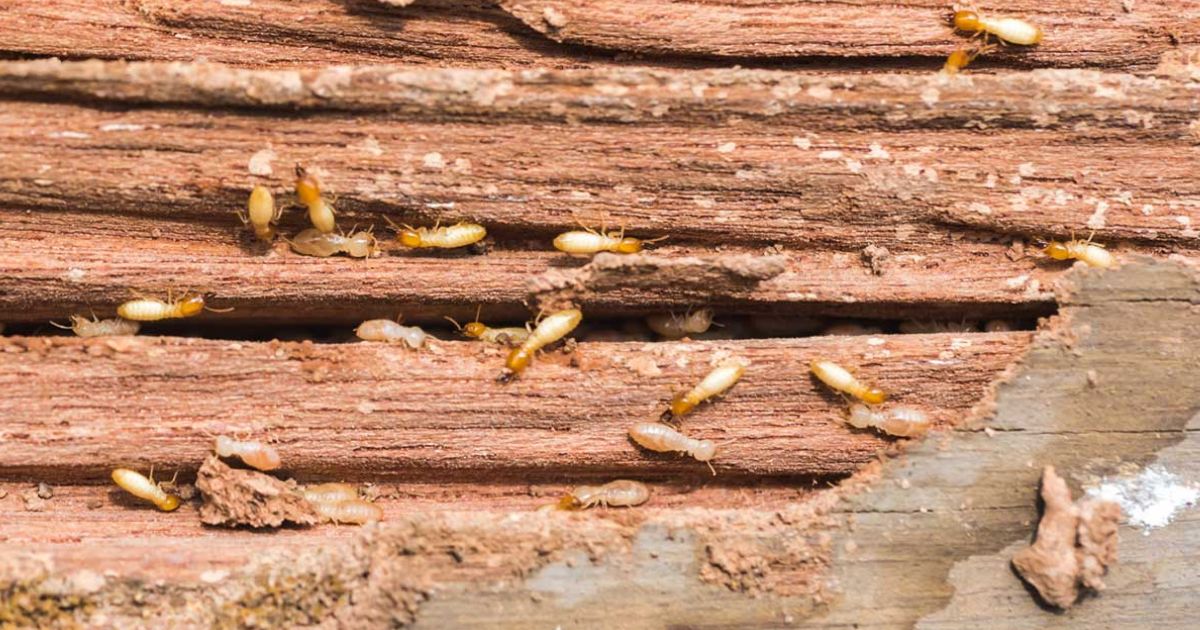
Tap on any leftover stump or wooden debris in the area. If it sounds hollow or feels soft and spongy, termites may be feeding inside. This hollowing occurs as termites eat the wood from the interior, preserving only the thin exterior layer.
Discarded Wings
After mating, termite swarmers (also known as alates) shed their wings near their nesting sites. Piles of these tiny, transparent wings around the stump, soil, or garden are a clear indication that a colony may be nearby.
Frass (Termite Droppings)
Drywood termites leave behind tiny wood-colored pellets known as frass. These droppings often collect around infested areas or at the base of trees and stumps. While not all species produce visible frass, its presence should not be ignored.
Swarming Termites
Seeing winged termites emerging from the ground or nearby soil is a direct sign of an active colony. Swarming usually occurs in warm, humid conditions, indicating that termites are trying to find new places to live.
Uneven or Damaged Soil
If you notice soft patches, raised tunnels, or disturbed soil around the tree removal site, termites might be tunnelling beneath the surface. Their underground networks can extend several feet from the original stump.
Being able to identify these signs early allows you to take action before termites spread to other parts of your property. The sooner you detect their presence, termite wood treatment the simpler and less costly it is to get rid of them.
Properly Removing the Tree Stump and Roots
Removing a tree is only half the battle; what’s left behind underground can still attract and sustain termites. A leftover stump and root system act as a food source for termite colonies, allowing them to thrive even after the tree is gone. Proper stump and root removal is therefore one of the most effective steps you can take to prevent termite reinfestation.
Why Stump Removal Is Essential
Termites feed on cellulose found in dead wood. The remaining stump and buried roots slowly decay, providing the perfect environment for termites to live and reproduce. How to Prune a Hydrangea in Spring for Healthy Growth If not removed, the colony can eventually move toward nearby structures, such as fences, sheds, or even your home’s foundation.
Methods for Stump Removal
a. Mechanical Stump Grinding
This is the fastest and most efficient method. A stump grinder shreds the wood below ground level, breaking it down into small chips. Once the area is ground, remove the wood detritus and add new dirt to the hole or gravel to discourage termite nesting.
b. Manual Digging and Root Extraction
If the stump is small, you can dig around it using a shovel and an axe to expose and cut away roots. This method is labour-intensive but ensures the removal of most of the wood material that could attract termites.
c. Chemical Stump Removers
Chemical stump removal products accelerate the decomposition of wood. They typically contain potassium nitrate or similar compounds. After drilling holes into the stump and applying the product, the stump will gradually soften, making it easier to remove. Always follow safety guidelines and avoid overuse near plants or water sources.
d. Natural Decomposition Methods
For a more eco-friendly option, apply Epsom salt, rock salt, or nitrogen fertiliser into drilled holes in the stump and keep the area moist. These substances speed up the natural rotting process, Types of Organic Mulch and Their Benefits reducing the wood’s appeal to termites over time.
Checking for Hidden Roots and Debris
After the central stump is removed, inspect the area for leftover roots or large wood pieces. Even small remnants underground can serve as food for termites. Dig around and remove as much wood as possible before backfilling the hole 4. Final Step: Soil Refill and Levelling.
Once the stump and roots are gone, fill the area with clean soil or gravel. Avoid using wood mulch in that spot, as it can attract new termites. Compact the soil firmly to reduce gaps where Moisture could accumulate, a condition termites love.By removing the entire stump along with its roots, you’re not just cleaning up your yard; you’re also cutting off a primary food source that could invite termites back into your property.
Treating the Soil After Tree Removal
Even after a tree stump and roots have been removed, the surrounding soil may still harbour termite colonies or eggs. Treating the soil is a crucial next step to ensure that any remaining termites are eliminated and that the area is no longer attractive to them. A well-treated soil barrier can prevent future infestations and protect nearby plants, wooden structures, and your home.
Why Soil Treatment Is Important
When termites infest a tree, their colonies often extend underground into the surrounding soil. Even after the tree is gone, termites can survive in these tunnels for months, searching for new food sources. By treating the soil, you destroy existing colonies and create a protective barrier that deters new termites from settling in.
Liquid Termiticides
One of the most effective ways to treat termite-prone soil is by applying a liquid termiticide. These products soak into the ground and form a chemical barrier that kills or repels termites on contact.
How to apply:
- Dig small trenches (about 4–6 inches deep) around the treated area.
- Pour or spray the termiticide evenly into the soil.
- Refill the trenches with treated soil.
Borate-Based Treatments
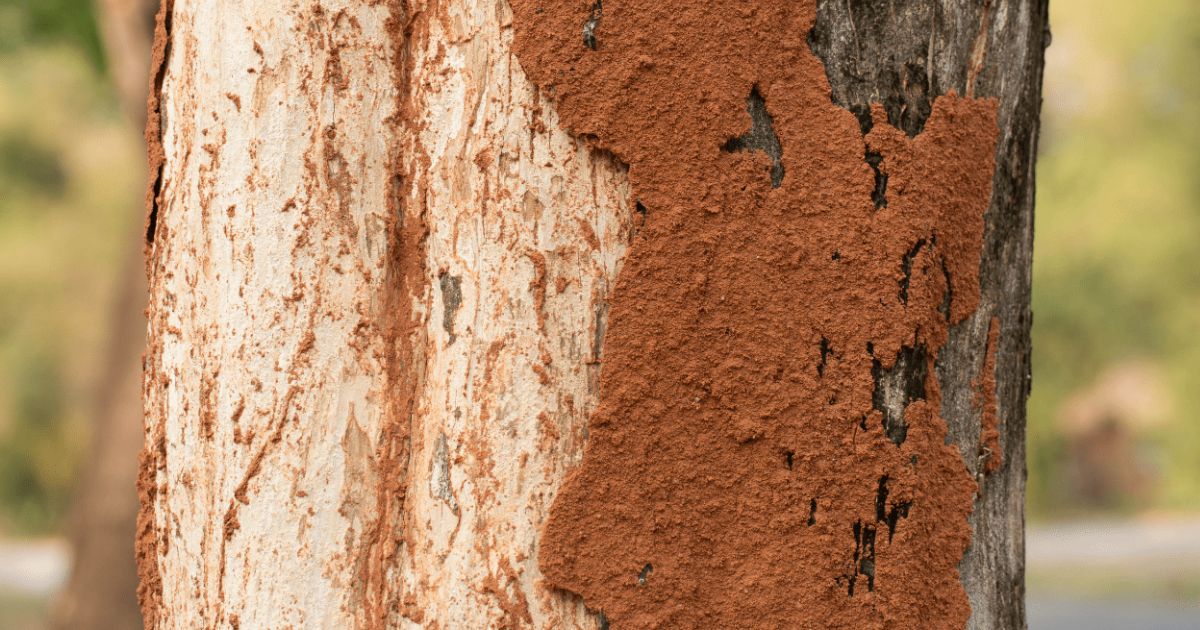
Borate products are safe, long-lasting, and effective against termites. They penetrate the soil and wood surfaces, killing existing insects while preventing new infestations.
- Mix borate powder with water and spray it over the treated soil area.
- Borates are also ideal for wooden fences, decks, or raised beds near the tree site.
Natural and Eco-Friendly Alternatives
There are several natural ways to lower termite risk if you would rather stay away from harsh chemicals:
- Diatomaceous earth: This fine powder damages termites’ exoskeletons, dehydrating and killing them. Sprinkle it in and around the treated area.
- Orange oil or neem oil: These natural oils have insecticidal properties How to Identify Fungi That Grows on Trees that can deter or kill termites. Mix with water and spray generously into the soil.
- Beneficial nematodes: These microscopic worms feed on termite larvae and can be mixed into the soil for biological control.
Improving Drainage and Reducing Moisture
Termites thrive in damp environments. treating wood for termites After treatment, make sure the soil drains well to prevent moisture buildup.
- Avoid overwatering the area.
- Redirect downspouts and sprinklers away from the treated zone.
- Consider adding sand or gravel to improve Drainage and reduce humidity.
Regular Soil Monitoring
Even after treatment, inspect the area every few months. Look for new termite tunnels or soft soil patches. If activity is detected, reapply your chosen treatment immediately.
By thoroughly treating the soil after tree removal, you create an invisible defence line against termites. This proactive step not only eliminates existing pests but also ensures long-term protection for your yard and nearby structures.
Disposing of Tree Debris Safely
Once a tree has been cut down and the stump removed, the next critical step is to properly dispose of the leftover wood, branches, roots, and sawdust. Many homeowners overlook this part, but if not correctly handled, tree debris can become a feeding ground for termites. These pests are naturally drawn to decaying wood. If the debris is left nearby, it can invite new infestations or encourage existing colonies to spread to your home or garden structures.
Why Proper Disposal Matters
Termites thrive on Moisture and dead wood. Piles of logs, branches, or mulch left on the ground create the perfect breeding environment. Even small wood chips or bark pieces can attract subterranean termites, especially during the rainy season. Proper cleanup ensures that you’re not unintentionally giving termites an open invitation to return.
Avoid Using Infested Wood for Mulch or Firewood
If the removed tree was already infested with termites, never reuse the wood for mulch or firewood near your home.
- Mulch risk: Mulch made from termite-infested wood can spread Why Scarifying Your Lawn Can Fix Grass Problems Fast the pests throughout your garden.
- Firewood risk: Storing infested logs near your house gives termites easy access to wooden walls, decks, or fences.
- If you’re unsure whether the tree was infested, it’s best to dispose of all wood rather than repurpose it.
Burning or Hauling Away the Debris
The safest disposal options include:
- Burning the debris: If local regulations allow open burning, this is the most effective way to ensure all termites and eggs are destroyed. Always follow fire safety guidelines and check community rules before burning.
- Hauling away: Contact your local waste management or tree removal service to haul away the wood debris. They can safely dispose of or recycle the material in a way that prevents the spread of termites.
Composting With Caution
If you plan to compost small pieces of wood or sawdust, make sure they are from a non-infested tree. Please place it in a hot compost pile (maintaining temperatures above 140°F/60°C) to kill any hidden termites. Avoid using large chunks of wood in compost, as they take too long to decompose and can attract pests.
Cleaning Up Sawdust and Smaller Debris
After cutting or grinding the stump, wood treated for termites remove any sawdust or wood shavings from the ground. These tiny wood particles retain Moisture and can attract subterranean termites. Sweep or rake the area clean and dispose of the waste in sealed bags.
Replace the Area With Non-Wood Material
Once debris is cleared, fill the area with clean soil, gravel, or stone. These materials discourage termite activity and help with Drainage. Avoid adding fresh wood mulch to the area for several months after removal to give the soil time to dry out completely.
Properly disposing of tree debris not only keeps your yard clean but also helps keep termites away. By removing every trace of old wood and choosing safe disposal methods, you cut off the termites’ primary food source and reduce the risk of future infestations.
Creating a Termite-Free Zone Around the Area
After removing a tree and treating the soil, the next step is to create a long-term defence system, a termite-free zone around your property. This protective buffer helps ensure that termites can’t find food, Moisture, or shelter near your home or garden. It’s a combination of good landscaping practices, regular maintenance, and moisture control that keeps termites away naturally.
Maintain a Clear Zone Around Buildings and Trees
Termites love tight, damp, and shaded spaces. Keep a clear zone of at least 12–18 inches between soil and any wooden structures, such as fences, decks, sheds, or your home’s foundation.
- Avoid stacking firewood, wooden planks, or mulch directly against your house.
- Trim nearby bushes and plants to allow sunlight and airflow, which helps the soil stay dry and less appealing to termites.
Use Gravel or Stone Borders Instead of Mulch
Mulch retains Moisture and provides termites with an ideal nesting ground. Instead, use gravel, crushed stone, or rubber mulch near the treated area and around building foundations.
- These materials discourage termites because they can’t feed on or burrow into them.
- Gravel borders also improve Drainage, reducing moisture buildup in the soil.
Control Moisture and Improve Drainage
Moisture is one of the biggest termite attractants. Even without wood present, damp soil can attract termites seeking a new food source.
- Fix leaking pipes, outdoor taps, or irrigation systems near the area.
- Make sure water is diverted from the foundation using gutters and downspouts.
- Grade the soil so that rainwater naturally flows away from your house and the treated zone.
Use Physical Barriers and Termite Shields
For added protection, you can install physical termite barriers when replanting or building near the area.
- Sand barriers: Fine sand or crushed granite can block termites from tunnelling upward.
- Metal termite shields: Placed under wooden structures or posts to stop termites from climbing into them.
- Plastic or mesh barriers: These can be installed beneath patios or garden beds to prevent termite access.
Apply Preventive Treatments Periodically
Even after initial soil treatment, it’s wise to reapply a borate or termiticide barrier every 2–3 years, especially in humid regions.
- Focus on areas with high soil contact termite proofing wood or wood exposure.
- Combine treatments with natural deterrents like orange oil or neem spray for added safety and eco-friendliness.
Keep Wood and Debris Away From the Treated Area
Store all wood materials, firewood, lumber, and mulch at least 20 feet away from your home and off the ground. Termites can travel through soil to reach new wood sources, so keeping a distance is key.
If you must store wood nearby, place it on a raised platform with metal legs to block termite access.
Regular Monitoring and Maintenance
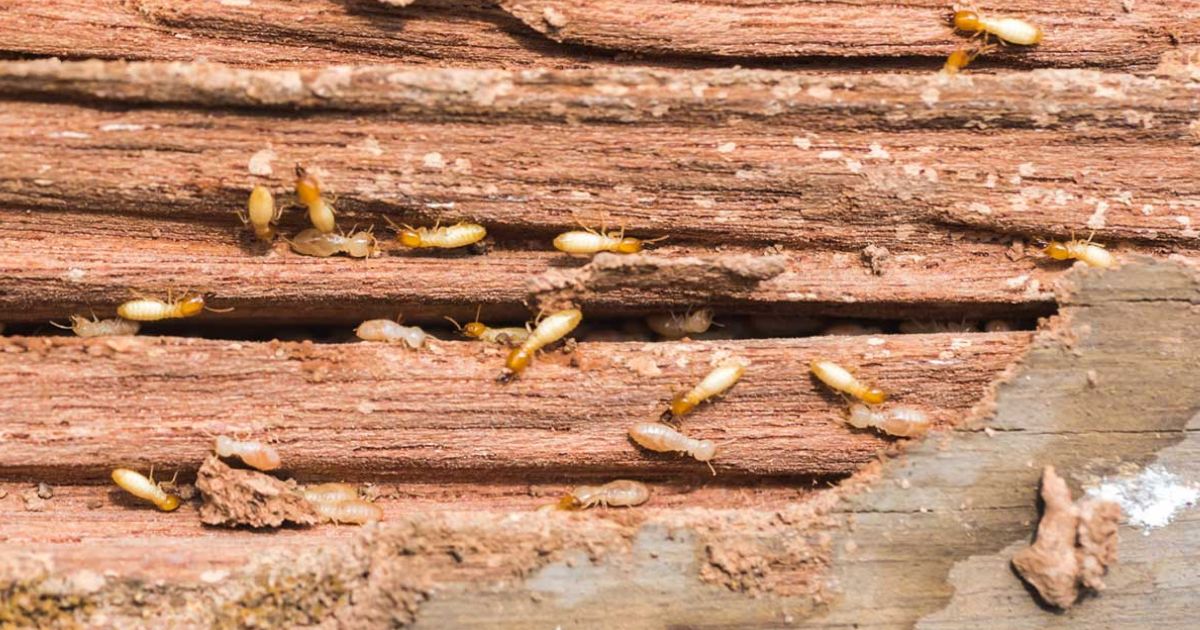
Termite prevention isn’t a one-time task. Inspect the area every few months for:
- New mud tubes or soft soil patches.
- Discarded termite wings or frass (droppings).
- Early signs of wood damage in nearby fences or structures.
Addressing these issues quickly helps you break the termite life cycle before it spreads.
By establishing a termite-free zone, you create a strong protective barrier that keeps your yard and home safe. With consistent maintenance and attention to moisture control, you can enjoy a healthy, pest-free landscape for years to come.
Conclusion
Cutting down a tree is only the first step in protecting your property from termites; what you do afterwards is just as important. Even after removal, leftover stumps, roots, and damp soil can continue to attract these silent destroyers. By taking proactive measures such as completely removing the stump, treating the soil, disposing of debris properly, and maintaining a termite-free zone, you can significantly reduce the risk of future infestations.
Preventing termites isn’t a one-time task; it’s about creating an environment where they have no reason to return. Regular inspections, good Drainage, and avoiding wood-to-soil contact are simple but powerful defences against these pests.With a bit of care and attention after tree removal, you can safeguard your garden, home, and structures from costly termite damage, ensuring your outdoor space remains healthy, beautiful, and termite-free for years to come.
FAQ
How long do termites stay after a tree is cut down?
Termites can remain in the soil for several months or even years after a tree is removed. If the roots or stump are left behind, they continue to provide food and shelter, allowing the colony to survive and grow. Proper stump removal and soil treatment are essential to eliminate them entirely.
Can termites spread from a dead tree to my house?
Yes, termites can easily migrate from a decaying tree stump to your home’s wooden structures. Once their food source runs out, they move through underground tunnels in search of new wood, which often leads them to decks, fences, or your house foundation.
Is it necessary to treat the soil after removing a tree?
Absolutely. Even after the tree is gone, termites often remain active in the surrounding soil. Treating the soil with termiticides, borates, or natural deterrents helps destroy existing colonies and prevent future infestations.
What natural remedies can help deter termites?
You can use orange oil, neem oil, diatomaceous earth, or beneficial nematodes as natural termite deterrents. These methods are eco-friendly and safe for gardens, though they may need reapplication over time for continued protection.
Can I use the removed tree’s wood as mulch or firewood?
It’s best not to. If the tree was infested, termites may still be inside the wood. Using it as mulch or storing it near your home could invite termites back. Always burn or dispose of the debris properly, far from your property.
How can I keep termites from returning after removal?
To keep termites away, remove all wood debris, improve soil drainage, use gravel instead of wood mulch, and maintain a gap between soil and wooden structures. Regular termite inspections every 6–12 months also help ensure your property remains protected.

